| This basilica was a project of Pope Sixtus III (432-40), probably erected near the ruins of an earlier church dedicated to the Virgin. This church appears to owe its beginning to the Council of Ephesus in 431, when Mary was officially declared the Mother of God. Pope Sixtus III then determined that a church dedicated to the Virgin should be built on the Esquiline Hill. |

|
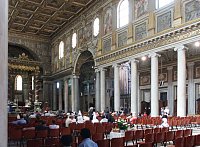
|
View of nave, looking westThe basilica has an unusual orientation with the entrance at the east and altar at the west--a reversal of the usual plan. The wide nave is marked off from the side aisles by two rows of twenty columns. The basilica was originally about 86 meters long and 32 1/2 meters wide. |
| |
|
Classical eleganceA classical revival is seen in several ways in this basilica: the forms and proportions are classical, the nave ends in a triumphal arch complete with narrative scenes, reminders of classical painting are evident in the nave mosaics, and, finally, imperial grandeur is asserted in this church as a way of associating the authority of the papacy with the glories of classical Rome. |
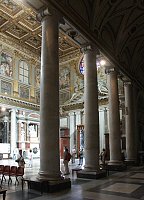
|

|

|
| |
|
The coffered wooden ceiling and the triumphal arch at the end of the naveThis ceiling was designed by Leon Battista Alberti (1406-72) and completed by Antonio da Sangallo the Elder (c. 1455-1534). |
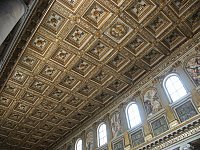
|

|
| |
|
Only the triumphal arch mosaics and those in the squares above the nave arcade are original--and all much restored. The triumphal arch mosaics are less realistic than those on the nave wall with static figures and a predominance of gold. These continuous scenes focus on New Testament events and symbolism relating to the infancy of Jesus. Mary, as Mother of God ("theotokos"), is depicted as queen of Heaven, usually enthroned and dressed regally. Jesus is often depicted as a youth or young adult, not as an infant or child. The bottom register on one side depicts Bethlehem, the city of David, the king from whose descendants Jesus was born, and on the other, Jerusalem, the place of Jesus' death and resurrection. Twelve sheep, six on each side look out the gates of each city. Left: New Testament scenes and a central medallion (a cross above a throne) flanked by Saint Peter and Saint Paul with the emblems above of the four evangelists; center: top register with enthroned Mary and bottom register with the adoration of the Magi, dressed as Zoroastrian priests in Phrygian caps |
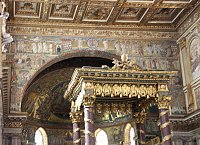
|
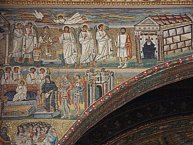
|

|
| |
|
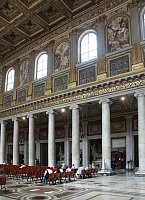
|
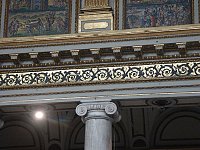
|
The Ionic colonnadeThis colonnade has an entablature with a rinceau (or foliate scroll pattern). Above the colonnade is a register with engaged fluted pilasters framing mosaics. Above that is a graceful clerestory, which originally had twice as many windows as now. |
| |
|
The nave mosaics with Old Testament stories of heroes and patriarchs beginning with AbrahamOnly 27 of the original 42 mosaic scenes remain. These mosaics are notable because they are somewhat realistic representations, often of miraculous events, with landscapes, blue skies, architecture in a kind of perspective, and modelled figures. At the same time, the forms are outlined and fairly flat. The representation on the left and center is of the capture of Jericho, with the walls tumbling down at the sound of the trumpets and with Rahab at the top of the city gate. The register below it depicts the procession of the ark of the Covenant to the sounds of trumpets. Joshua is just to the right of the ark. Thanks to Sharon Gregory for identifying the right image: it is from the story of Joshua, and shows on the top, the angel appearing to Joshua (Joshua 5: 13-16), and on the bottom, Rahab helping Joshua’s two spies to escape from Jericho by means of a rope (Joshua 2).
|
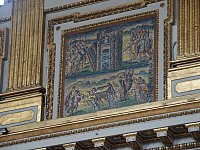
|
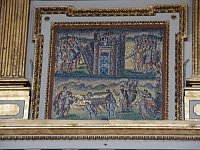
|

|


 Click here to return to index of art historical sites.
Click here to return to index of art historical sites.
 Click here to return to index of artists and architects.
Click here to return to index of artists and architects.
 Click here to return to chronological index.
Click here to return to chronological index.
 Click here to see the home page of Bluffton University.
Click here to see the home page of Bluffton University.
